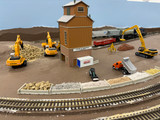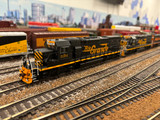Iron Horses: The Birth of American Railroads
The story of American railroads is a tale of innovation, ambition, and transformation. It's a narrative that shaped the nation, connecting vast distances, fostering economic growth, and forging the modern United States. The birth of American railroads in the 19th century marked a pivotal moment in history, forever changing the way people and goods moved across the country. In this article, we explore the early origins of railroads in the United States, the significance of the "Tom Thumb" locomotive, and the emergence of the Baltimore and Ohio Railroad.
The Early Origins of Railroads in the United States
The roots of American railroads can be traced back to the early 19th century when the young nation was experiencing rapid westward expansion. At the time, canals were the primary means of transportation for goods, but they had limitations. They were often slow, subject to weather conditions, and unable to traverse rugged terrains. The need for a more efficient transportation system became evident, and the idea of building railroads began to gain traction.
One of the first documented instances of railroad use in the United States dates back to the early 18th century when wooden tracks were constructed in mines to facilitate the movement of ore carts. However, the development of steam-powered locomotives was the key breakthrough that would revolutionize transportation.
The Significance of the "Tom Thumb" Locomotive
In 1829, the world witnessed a pivotal moment in the history of railroads with the creation of the "Tom Thumb," a small but powerful locomotive built by Peter Cooper. This steam locomotive marked a significant leap forward in railway technology, showcasing the potential of steam power for transportation. The "Tom Thumb" was notable for its ability to pull heavy loads at speeds previously unimaginable.
Perhaps the most famous demonstration of the "Tom Thumb" locomotive's capabilities occurred on August 28, 1830, in Baltimore, Maryland. The "Tom Thumb" faced off against a horse-drawn carriage in a race on the Baltimore and Ohio Railroad (B&O). In a dramatic race that captured the public's imagination, the "Tom Thumb" initially outpaced the horse-drawn carriage. However, it suffered a mechanical failure, allowing the horse to win the race. Despite the setback, the event showcased the potential of steam locomotives and generated immense interest in railway development.
The Emergence of the Baltimore and Ohio Railroad
The Baltimore and Ohio Railroad, chartered in 1827, holds a special place in the history of American railroads. It was the first common carrier railroad in the United States, designed to transport both passengers and freight. The B&O was also the first railroad to employ steam locomotives for regular service, with the "Tom Thumb" being one of its early pioneers.
On May 24, 1830, the B&O officially began construction in Baltimore, Maryland. It aimed to connect Baltimore with the Ohio River, a distance of over 380 miles, making it one of the most ambitious infrastructure projects of its time. The construction involved numerous engineering challenges, including tunnels, bridges, and steep grades. However, through innovation and determination, the B&O gradually overcame these obstacles.
The B&O's successful use of steam locomotives and the completion of its mainline in 1852 marked a turning point in American transportation. It significantly reduced travel time and costs, opening up new opportunities for trade and travel. The success of the B&O Railroad set the stage for the rapid expansion of railroads across the United States.
In conclusion, the birth of American railroads was a transformative moment in history, reshaping the nation's landscape and economy. The "Tom Thumb" locomotive and the emergence of the Baltimore and Ohio Railroad played pivotal roles in this revolution, demonstrating the potential of steam power and the feasibility of transcontinental rail travel. These early developments paved the way for an extensive network of railroads that would connect the country, laying the tracks for the United States' economic and social growth in the years to come. The iron horses had arrived, and they were here to stay, propelling America into a new era of progress and prosperity.
Recent Posts
-
Enhancing Your Model Railroad: Adding Spectacular Special Effects
Embarking on the journey of model railroading opens up a world of creativity and craftsmanship, wher
-
All Aboard the Wisdom Express: Life Lessons from Model Railroading
Embarking on the journey of model railroading opens the door to a world where imagination meets prec
-
Capturing History in Miniature: The Art of Prototype Modeling in the Model Railroad World
Prototype modeling in the model railroad world involves creating miniature replicas of real-life tra




